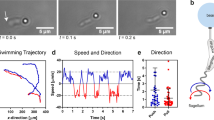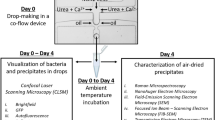Abstract
Scanning microfluorimetric techniques offer a means for in situ investigation of spatial heterogeneities in biomass density and cell composition in macroscopic, aggregate-cell systems such as immobilized-cell biocatalysts, biofilms, mold pellets and tumors. Much of the analytical power of flow cytometry, with the important addition of spatial resolution, can be brought to bear on the study of these systems. The utility of these techniques is demonstrated for the experimental determination of spatial gradients in biomass density and bio-catalytic activity in Ca-alginate beads containing an entrapped, living bacterium, Zymomonas mobilis ATCC 10988. Using cell RNA content as an indicator of cell growth rate, scanning microfluorimetry data indicates that immobilized cells in a single gel bead can exhibit the fullest possible variation in specific growth rates, from maximal to resting. Thus, clear gradients in biological growth rate within such biocatalysts are quantifiable, with implications for any fully or partially growth associated products.
This is a preview of subscription content, access via your institution
Access options
Subscribe to this journal
Receive 12 print issues and online access
$209.00 per year
only $17.42 per issue
Buy this article
- Purchase on Springer Link
- Instant access to full article PDF
Prices may be subject to local taxes which are calculated during checkout
Similar content being viewed by others
References
Karel, S.F., Libicki, S.B., and Robertson, C.R. 1985. The immobilization of whole cells: engineering principles. Chem. Eng. Sci. 40:1321–1354.
Mattiasson, B. 1983. Immobilized cells and organelles. CRC Press, Boca Raton, FL.
Scott, C.D. 1987. Immobilized cells: a review of recent literature. Enz. Microb. Technol. 9:66–73.
Mattiasson, B., and Hahn-Hägerdal, B. 1982. Microenvironmental effects on metabolic behaviour of immobilized cells: a hypothesis. J. Appl. Microbiol. Biotech. 16:52–55.
Sernetz, M., Hannibal-Friedrich, O., and Chun, M. 1979. Bestimmung radialer dichtegradienten in oxiran-acrylharzperlen durch mikroin-terferometrie und mikrofluorometrie. Micros. Acta. 81:393–406.
Pearse, A.G.E. 1980. Histochemistry: theoretical and applied. Churchill Livingstone, Edinburgh.
Shinmyo, A., Kimura, H., and Okada, H. 1982. Physiology of α-amylase production by immobilized Bacillus amyloliquefaciens. Eur. J. Appl. Microbiol. Biotech. 14:7–12.
Baudet, C., Barbotin, J.-N., and Guespin-Michael, J. 1983. Growth and sporulation of entrapped Bacillus subtilis cells. Appl. Environ. Microbiol. 45:297–301.
Garde, V.L., Thomasset, B., and Barbotin, J.-N. 1981. Electron microscopic evidence of an immobilized living cell system. Enz. Microb. Technol. 3:216–218.
Dhulster, P., Barbotin, J.-N., and Thomas, D. 1984. Culture and bioconversion use of plasmid-harboring strain of immobilized E. coli. Appl. Microbiol. Biotech. 20:87–93.
de Taxis du Poët, P., Dhulster, P., Barbotin, J.-N., and Thomas, D. 1986. Plasmid inheritability and biomass production: comparison between free and immobilized cell cultures of Escherichia coli BZ18 (pTG201) without selection pressure. J. Bac. 165:871–877.
Harder, A., and Roels, J.A. 1982. Application of simple structured models in bioengineering. Adv. Biochem. Eng. 21:55–107.
Brachet, J. 1953. The use of basic dyes and ribonuclease for the cytochemical detection of ribonucleic acid. Quart. J. Micros. Sci. 94:1–10.
Kurnick, N.B. 1955. Pyronin Y in the methyl-green-pyronin histological stain. Stain Technol. 30:213–230.
Scott, J.E. 1967. On the mechanism of the methyl green-pyronin stain for nucleic acids. Histochem. 9:30–47.
Ahlqvist, J. 1972. Methyl green-pyronin staining: effects of fixation; use in routine pathology. Stain Technol. 47:17–22.
Shapiro, H.M. 1981. Flow cytometric estimation of DNA and RNA content in intact cells stained with hoechst 33342 and pyronin Y. Cytometry 2:143–150.
Swings, J., and de Ley, J. 1977. The biology of Zymomonas. Bac. Rev. 41:1–46.
Rogers, P.L., Lee, K.J., Stotnicki, M.L., and Tribe, D.E. 1982. Ethanol production by Zymomonas mobilis. Adv. Biochem. Eng. 23:37–84.
Rogers, P.L., Stotnicki, M.L., Lee, K.J., and Lee, J.H. 1984. Recent developments in the Zymomonas process for ethanol production. CRC Crit. Rev. Biotech. 1:273–288.
Jöbses, I.M.L., Egberts, G.T.C., van Baalen, A., and Roels, J.A. 1985. Mathematical modelling of growth and substrate conversion of Zymomonas mobilis at 30 and 35°C. Biotech. Bioeng. 27:984–995.
Hanson, R.S., and Phillips, J.A. 1981. Chemical composition, p. 328–364. In: Manual of methods for general bacteriology. P. Gerhardt (Ed.). American Society for Microbiology, Washington, D.C.
Lillie, R.D., and Fullmer, H.M. 1976. Histopathologic Technique and Practical Histochemistry. McGraw-Hill, New York.
Author information
Authors and Affiliations
Rights and permissions
About this article
Cite this article
Monbouquette, H., Ollis, D. Scanning Microfluorimetry of Ca-Alginate Immobilized Zymomonas Mobilis. Nat Biotechnol 6, 1076–1079 (1988). https://doi.org/10.1038/nbt0988-1076
Received:
Accepted:
Issue Date:
DOI: https://doi.org/10.1038/nbt0988-1076



